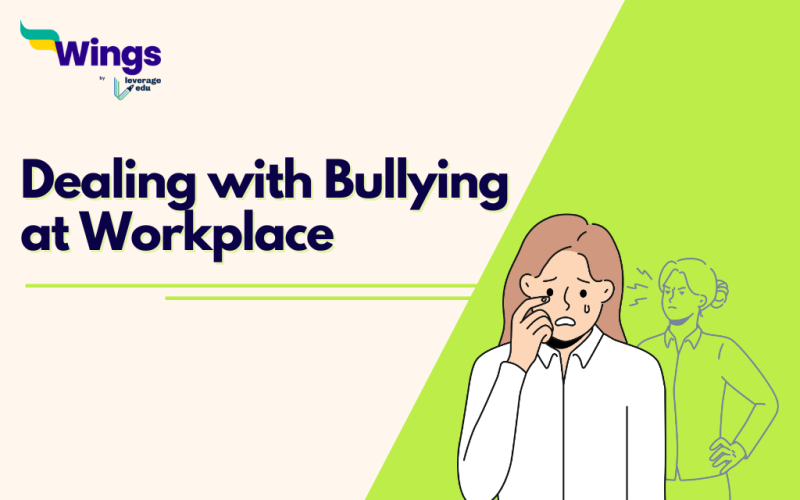Workplace bullying is the repetitive targeting of an individual or group with harmful actions, leading to a hostile work atmosphere. To handle this, record incidents, assert boundaries, and maintain professionalism. Seek support from trustworthy colleagues and report the misconduct to the Human Resource (HR) manager or a supervisor. Be knowledgeable about company policies and, if necessary, request mediation or an inquiry. Give importance to self-care and contemplate seeking expert guidance. Addressing bullying is essential for a positive work environment.
This Blog Includes:
Also Read: How to Find a Mentor at the Workplace?
What is Workplace Bullying?
Workplace bullying refers to repeated, harmful behaviours directed towards an individual or a group of individuals in a professional setting. These behaviours can be verbal, physical, or psychological, and they create a hostile work environment. Examples of workplace bullying may include verbal abuse, offensive jokes, humiliation, intimidation, or even sabotage of someone’s work.
Examples of Bullying at Work
There are several forms of workplace bullying which are reflective of one’s behaviour. Recognising these behaviours is crucial for addressing and preventing workplace bullying. If you or someone you know is experiencing any of these forms of bullying, it’s important to take action and report it to the appropriate authorities or HR department.
Here are some common examples of harassment at work
- Verbal Abuse: Using offensive, insulting, or derogatory language towards a colleague.
- Public Humiliation: Criticising or mocking someone in front of others, intentionally embarrassing them.
- Exclusion or Isolation: Deliberately leaving out a colleague from meetings, activities, or social interactions.
- Undermining Work: Sabotaging or intentionally hindering a colleague’s work progress or projects.
- Spreading Rumors or Gossip: Circulating false or damaging information about a colleague to undermine their reputation.
- Intimidation: Using threats, physical posturing, or aggressive behaviour to create fear or anxiety in a colleague.
- Micromanagement: Excessively controlling or scrutinising a colleague’s work, leaving them feeling undermined and disempowered.
- Excessive Workload: Deliberately overloading a colleague with tasks or responsibilities beyond their capacity, leading to stress and burnout.
- Cyberbullying: Sending hostile, offensive, or threatening messages or emails to a colleague through digital means.
- Discrimination: Treating a colleague unfairly or unfavourably based on their race, gender, age, religion, or other protected characteristics.
Also Read: How to Say No Politely at Workplace
How to Deal with Workplace Bullying?
Dealing with workplace bullying can be challenging, but it’s important to take action to protect your well-being and professional environment. Always remember that addressing workplace bullying is crucial for maintaining a healthy and productive work environment. Therefore, do not hesitate to reach out to your colleagues and higher management to protect yourself and other victims.
Here are some steps you can take:
Record the Incidents: Keep a detailed record of each instance of bullying, including dates, times, locations, people involved, and a description of what happened. This will serve as evidence if needed.
Maintain Professionalism: Respond calmly and professionally when faced with bullying. Avoid engaging in aggressive or retaliatory behaviour, as it may escalate the situation.
Set Boundaries: Politely but firmly assert your boundaries. Let the bully know their behaviour is not acceptable and request that it stop.
Seek Support: Talk to trusted colleagues, friends, or family members about the situation. They can offer emotional support and may provide valuable insights or advice.
Request a Mediation or Investigation: If appropriate, suggest or request a mediation session involving a neutral third party to address the issue. If the bullying persists, ask for a formal investigation.
Familiarise Yourself with Company Policies: Know your rights and the policies in place regarding workplace harassment. This can guide your actions and help you understand the steps your company should take in response.
Seek Professional Advice: If the bullying continues or escalates, consider consulting with an employment lawyer or a legal advisor to understand your rights and potential courses of action.
Take Care of Your Well-being: Practice self-care and prioritise your mental and emotional health. Engage in activities that help reduce stress and maintain a healthy work-life balance.
Explore Other Options: If the situation doesn’t improve, consider seeking a transfer to a different department or exploring job opportunities elsewhere.
Also Read: 15+ Tips to Get Noticed at Work
FAQs
To handle this, record incidents, assert boundaries, and maintain professionalism. Seek support from trustworthy colleagues and report the misconduct to the Human Resource (HR) manager or a supervisor.
You can repost to your supervisor or HR if you are being harassed by your peer or any other colleague. Whereas, if your supervisor/team lead/manager is bullying you, you can report it to the HR department.
Harassment at work can take place in the form of verbal abuse, public humiliation, intimidation, micromanagement of work, cyberbullying, and discrimination on the basis of gender, race, religion, caste, etc.
Related Blogs:
For more such informative blogs, visit the career counselling page and stay tuned with Leverage Edu.
 One app for all your study abroad needs
One app for all your study abroad needs














 45,000+ students realised their study abroad dream with us. Take the first step today.
45,000+ students realised their study abroad dream with us. Take the first step today.

